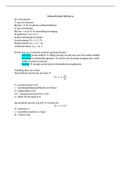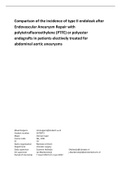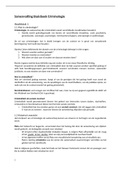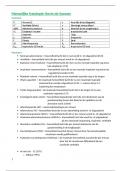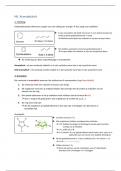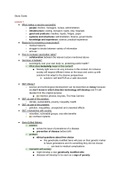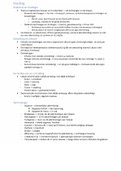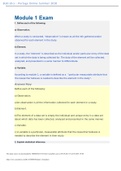INHOUD
Informatie vak .................................................................................................... 5
Studiemateriaal .................................................................................................. 5
Hoofdstukken (in volgorde) .................................................................................. 5
WPO ................................................................................................................. 5
onderdelen......................................................................................................... 5
examen ............................................................................................................. 5
1. inleiding .................................................................................................... 6
1.1. Cognitieve wetenschappen ......................................................................... 6
1.2. Wetenschappelijke methoden ..................................................................... 6
1.3. Afhankelijke variabelen .............................................................................. 7
1.4. populaties ................................................................................................ 7
1.5. Theorie .................................................................................................... 7
1.6. verband onderzoek en theorievorming ......................................................... 8
2. geschiedenis ............................................................................................. 9
2.1. inleiding ................................................................................................... 9
2.2. eerste cognitieve psychologen .................................................................... 9
2.3. opkomst behaviourisme ............................................................................14
2.3.1. cognitieve psycholoie vs. behaviourisme ...............................................14
2.3.2. eerste helft 20ste eeuw ........................................................................14
2.3.3. over het behaviourisme ......................................................................15
2.3.4. kritiek Behaviourisme .........................................................................15
2.3.5. leerexperimenten ...............................................................................16
2.3.6. open black box ..................................................................................17
2.4. Cognitieve revolutie ..................................................................................17
2.4.1. BINAC: Binary Automatic computer (1949) ...........................................18
2.4.2. IBM (1954)........................................................................................18
2.4.3. computermodel ..................................................................................18
2.4.4. AI – Artificiële intelligentie ...................................................................20
2.4.5. 1956: geboortejaar ............................................................................20
2.4.6. groei cognitieve psychologie ................................................................20
2.4.7. cognitieve revolutie ............................................................................21
2.4.8. Miller ................................................................................................21
2.5. Hedendaagse cognitieve psychologie ..........................................................21
2.5.1. de theorie van cognitie? ......................................................................21
1
,3. perceptie ................................................................................................. 22
3.1. wat is perceptie? ......................................................................................22
3.1.1. interne representatie ..........................................................................22
3.1.2. van prikkel tot perceptie .....................................................................22
3.2. psychofysica ............................................................................................25
3.2.1. detectiedrempel .................................................................................25
3.2.2. Verschildrempel .................................................................................26
3.2.3. Wet van Weber ..................................................................................26
3.2.4. drempels ...........................................................................................27
3.2.5. schaal(probleem) ...............................................................................27
3.3. objectherkenning .....................................................................................28
3.3.1. van waarneming naar herkenning ........................................................28
3.3.2. Bottom-up vs. top-down verwerking .....................................................28
3.3.3. modellen objectherkenning ..................................................................28
3.4. gezichtsherkenning ...................................................................................34
3.4.1. prototypische modellen .......................................................................34
3.4.2. fusiforme face area ............................................................................34
3.4.3. perceptuele expertise .........................................................................34
4. aandacht ................................................................................................. 36
4.1. Wat is aandacht? ......................................................................................36
4.2. selectieve aandacht ..................................................................................36
4.2.1. exogene en endogene aandacht ...........................................................36
4.2.2. change blindness ...............................................................................38
4.2.3. inattentional blindness ........................................................................38
4.2.4. aandacht vs. oogfixatie .......................................................................39
4.2.5. plaatsgebonden aandacht/ locatiegebonden aandacht .............................41
4.2.6. voorwerpgebonden aandacht ...............................................................41
4.2.7. hemineglect.......................................................................................42
4.2.8. vroege vs. late selectie .......................................................................44
4.2.9. Late selectie ......................................................................................47
4.2.9.2. subliminale priming .........................................................................48
4.2.10. vroege vs late selectie? ....................................................................49
4.2.11. capaciteitsmodel aandacht ...............................................................50
4.2.12. perceptueal load model: Lavie (1995) ................................................50
4.3. verdeelde aandacht ..................................................................................52
4.3.1. Automaticiteit ....................................................................................52
Strooptraak congruente conditie .......................................................................52
2
, Strooptraak incongruente conditie .....................................................................53
Schneider & shiffrin (1977) ..............................................................................53
Instance theory of automaticity (Logan, 1988) ...................................................55
Norman & Shallice’s (1986) SAS .......................................................................56
Supervisory attentional system .........................................................................57
4.4. neurale basis aandacht .............................................................................58
4.4.1. Posner & Rothbart (2007) aandachtsnetwerken......................................58
5. Kortetermijngeheugen ............................................................................ 61
5.1. Geheugen ...............................................................................................61
5.2. William James (1890) ...............................................................................61
5.3. KTG vs. LTG ............................................................................................61
5.3.1. Vrije herinnering (Murdock, 1962) ........................................................61
5.3.2. Seriële positiecurve (Murdock, 1962) ....................................................62
5.3.3. Dubbele dissociatie .............................................................................62
5.3.4. Hypothesen Glanzer en Cunitz (1966) ...................................................62
5.3.5. Patiënt H.M. ......................................................................................63
5.3.6. Clive Wearing ....................................................................................64
5.4. Modaalmodel Atkinson & Shiffrin (1968) ......................................................65
5.4.1. Geheugenprocessen ...........................................................................65
5.5. Sensorisch register ...................................................................................66
5.5.1. Capaciteit iconisch geheugen ...............................................................66
5.5.2. Duur iconisch geheugen ......................................................................67
5.5.3. Echoïsch geheugen (Darwin, 1972) ......................................................68
5.5.4. Van SR naar KTG ...............................................................................68
5.6. KTG ........................................................................................................69
5.6.1. capaciteit KTG ...................................................................................69
5.6.2. Duur KTG ..........................................................................................69
5.6.3. Vergeten in KTG .................................................................................70
5.6.4. Ophalen in KTG ..................................................................................70
5.7. Werkgeheugenmodel ................................................................................73
5.7.1. Modaalmodel KTG ..............................................................................73
5.7.2. Hypothesen Baddeley en Hitch (1974) ..................................................74
5.7.3. Werkgeheugenmodel (Baddeley, 2000) .................................................75
5.7.4. Stoornissen .......................................................................................79
5.7.5. Executieve functies .............................................................................80
5.7.6. Trial Making Test – Deel B ...................................................................81
5.7.7. Conflicttaken Simontaak .....................................................................81
3
, 5.7.8. N-back taak .......................................................................................82
5.7.9. Ter illustratie .....................................................................................82
5.7.10. Episodische buffer ...........................................................................82
5.7.11. Werkgeheugen................................................................................82
5.6. Model Cowan: geheugenmodel cowan (1988) ..............................................83
5.6.1. aandachtsfocus: the magical number 4 .................................................85
6. langetermijngeheugen ............................................................................ 86
6.1. introductie LTG ........................................................................................86
6.2. Structuur LTG ..........................................................................................86
6.2.1. Taxonomie Squire & Knowlton (1994) ...................................................86
6.2.2. Indeling LTG ......................................................................................87
6.2.3. Retrograde amnesie ...........................................................................88
6.2.4. Wet van Ribot ....................................................................................88
6.2.5. Standaard consolidatietheorie Squirre en Alvares (1995) .........................89
6.2.6. Expliciet vs. impliciet geheugen............................................................91
6.2.7. Graf, squire en Mandler (1984) ............................................................91
6.3. expliciet geheugen ...................................................................................92
6.3.1. taxonomie Squire & Knowlton (1994) ...................................................92
6.4. Semantisch geheugen ...............................................................................93
6.5. Episodisch geheugen ................................................................................97
6.5.1. taxonomie Squire & Knowlton (1994) ...................................................97
6.5.2. episodisch geheugen ..........................................................................97
6.5.3. autobiografisch geheugen ...................................................................98
6.5.4. Flitslichtherinneringen .........................................................................98
6.5.5. Ooggetuigenissen ............................................................................. 100
6.5.6. Loftus en Palmer (1974) ................................................................... 100
6.5.7. conclusie ......................................................................................... 100
6.5.8. verhaal van Piaget ............................................................................ 100
6.5.9. de ballonvaart (wade e.a., 2002) ....................................................... 101
6.5.10. conclusie ...................................................................................... 101
6.5.11. Opslag in LTG ............................................................................... 101
6.5.12. Voorbeelden ................................................................................. 102
6.5.13. Vergeten in LTG ............................................................................ 103
4

